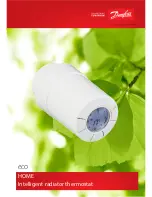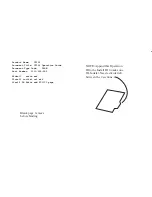
Hand-held
Infrared Radiation
Thermometer
IRT-100-TA
s
Instruction Manual
Read this manual before using the instrument.
SHINKO TECHNOS CO., LTD.
CE Marking: Conforms to EMC directive(89/336/EEC, 92/31/EEC
amendment,93/68/EEC amendment)
EN55011 Group 1, Class B, EN50082-1
■Specifications
Measuring range
-40 to 500℃
Detecting element
Thermopile
Measuring wavelength
8 to 14 μm
Measuring diameter
φ45/500mm (Optical sensitivity: 90%)
Measuring accuracy
Within ±1% of measured value or within ±2℃,
whichever is greater. However,
–
30 to 0℃:
Within±3℃, Lower than -30℃: Within±5℃
(At 25
℃ ambient temperature)
Repeatability
Within ±1℃
Stability
±5℃ (under EMC test)
Response time
0.8 seconds (90% response)
Collimation
Laser beam marks the center of the area
measured
Beam diameter
Approx. 5mm (at a distance of 1m)
Beam output
Less than 1mW , 670nm (IEC, class Ⅱ)
Display indications
Current reading, Maximum reading, Minimum
reading, Reading hold, Emissivity, Alarm value,
Low battery
Auto power off
Automatically shuts power off in 30 seconds
after Reading hold
Alarm
High limit alarm (with a beeper)
Emissivity correction
Selectable from DARK (0.95), BRIGHT (0.80),
FREE (variable from 0.30 to 1.90, Initial value:
1.00)
Display illumination
Automatic back-light
Operating temperature
0 to 50℃
Storage temperature
-20 to 55℃
Power source
Alkaline battery, AA (UM-3) type, 2 pieces
Battery life
Approx. 50 hours for continuous measurement
Dimension
81 (W) x 142 (H) x 32 (D) mm
Weight
Approx. 180g
Accessories
Alkaline battery AA (UM-3) type, 2 pieces
Instruction manual, 1 copy
Vinyl case, 1 piece
CAUTION - Laser Light
Do not aim laser beam toward faces.
Do not stare into beam or into reflections of the beam
off mirror-like surfaces.
Do not attempt to open the housing, other
than to change the batteries. There are no other
user-serviceable parts inside.
■Safety Precautions
●Do not touch the instrument on an object being tested. A contact with an
object at a high temperature can cause irreparable damage to the instrument
or inaccurate readings.
●Do not touch the measuring window of the instrument with hard objects.
Do not let foreign objects penetrate the measuring window or a hard object
drop on the window.
●Always put the cap back on the measuring window after measurement to
prevent foreign objects from penetrating the window.
●In order to protect the optical system of the instrument, do not subject the
instrument to extreme shocks and vibration.
●Keep the instrument away from objects with built up static charges.
●Select the proper emissivity value for accurate readings.
●When there is a rapid change to the ambient temperature, wait a while to let
the temperature of instrument stabilize for accurate readings.
●When the instrument is put in storage or not in use for a long period of time,
remove the batteries from the instrument.
●Do not use or store the instrument at a location where;
temperature and/or humidity are high,
the instrument is exposed to the direct sunlight,
there is a lot of dust.,
there are greasy fumes or corrosive gasses,
as the measuring window may become deteriorated or soiled, causing
inaccurate readings.
●Do not use the instrument in water or other fluids. Do not store the instrument
where it can come into contact with water.
●Keep the instrument away from objects which produce a strong magnetic field.
■Relation of Distance and
Measuring Diameter
The figure below shows the required minimum area (optical sensitivity: 90%) on
an object being tested at a distance of 500mm and 1000mm.
The measured area increases with distance.
When measuring, the distance should be as short as possible.
■Troubleshooting
■Maintenance
Measuring Window
Dust, stains and flaws on the measuring window cause inaccurate readings.
Wipe stains off with a soft cloth used for lenses of camera. Use absorbent cotton
dipped into neutral detergent diluted with water to remove tough stains.
Note
Use of other substance other than neutral detergent can damage the window to
cause the laser beam to scatter.
Other Parts of the Instrument
Clean the instrument with a dry cloth. To remove tough stains, use a damp cloth
from which water-diluted neutral detergent has been rinsed out. Use of paint
thinner, benzine, alcohol and other chemicals may blur the display window, erase
markings or cause the enclosures to crack. It is preferable to keep the instrument
in the carrying case.
No.IRTTA11E1 2001.12
SHINKO TECHNOS CO.,LTD.
OVERSEAS DIVISION
:
:
:
:
Reg. Office
Mail Address
URL
E-mail
2-48, 1-Chome, Ina, Minoo, Osaka, Japan
P.O.Box 17, Minoo, Osaka, Japan
http://www.shinko-technos.co.jp
[email protected]
Tel :
Fax:
81-727-21-2781
81-727-24-1760
Symptoms
Causes
Countermeasures
No display appears.
Batteries have been used up or they have not
been inserted correctly.
Replace or insert them correctly.
Laser beam is not
emitted or is weak.
Battery voltage is low.
Measurement is possible. Replace batteries when the laser maker is
necessary.
Cap is not removed.
Check if the cap has been removed.
Measuring window is dirty.
Clean the measuring window, referring to the“Maintenance” section.
Measurement was done with maximum or
minimum reading.
Check the measuring condition. Switch it to current reading.
Heat source nearby affects the measurement.
Shield the heat source with a shielding plate.
Emissivity is not selected properly.
If emissivity is unknown, refer to“Reference”. Or measure temperature
with a contact type thermometer and obtain adequate emissivity by
changing it to have same temperature as measured on condition of
emissivity selection at FREE.
Target area is too small.
Check the target area and keep a sufficient area for measurement.
Unstable reading
Unit is affected by rapid temperature change.
Leave unit alone to stabilize its temperature, then measure.
Out of measuring temperature range.
Check the target to be measured.
Emissivity selection setting is not matched.
Same as above countermeasure.
Reading is blinking.
Ambient temperature is out of specified range.
Check operation environment.
Abnormal reading.
No reading appears
but display is 【---】.




















